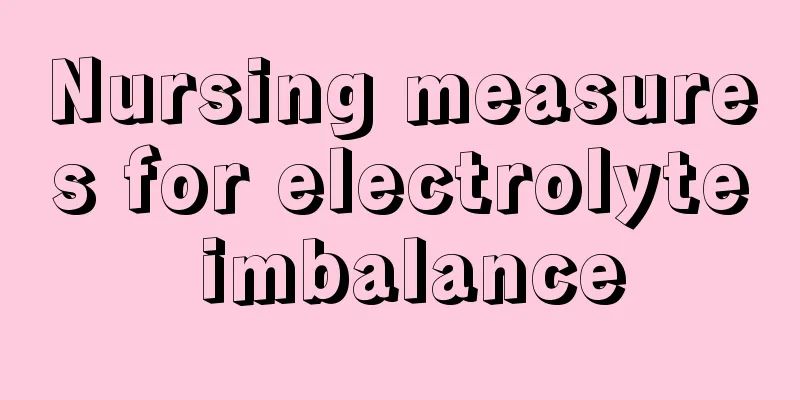Can thrombosed hemorrhoids be plugged in?

|
We often develop hemorrhoids due to improper bowel movements or excessive pressure. Thrombosed hemorrhoids are a type of external hemorrhoids. There are many factors that cause it, such as frequently eating spicy and irritating foods. Once thrombosed external hemorrhoids appear, it may cause anal swelling and pain, or a feeling of foreign matter in the anus. Therefore, many people with this type of hemorrhoids often want to plug the hemorrhoids. So, can thrombosed hemorrhoids be plugged in? 1. Can it be stuffed in? If the symptoms of thrombosed external hemorrhoids are mild, they can be pushed back into the anus. If they are severe, it is not recommended to push them back in, otherwise it will cause more edema and even severe pain. The key is to adjust your lifestyle, do not eat irritating and hot foods, do not scratch, do not stay up late, have bowel movements every day, take a warm potassium permanganate bath after defecation, use hemorrhoid cream or hemorrhoid suppositories locally, and surgical treatment if severe. 2. Causes 1. Poor blood circulation Defecation increases abdominal pressure, which can easily obstruct blood circulation in the abdomen; the venous blood in the rectum does not flow smoothly when passing through the blood vessels in the anus; the mucosal tissue in the anus relaxes, causing the venous blood lining to thin; poor anorectal circulation causes the venous blood to expand rapidly, accumulate for a long time, and cause congestion, thus forming thrombosed external hemorrhoids. 2. Lifestyle issues Bad bowel habits: squatting in the toilet for a long time can easily put pressure on the venous blood, resulting in poor circulation, which can cause thrombosed external hemorrhoids; excessive stress: excessive pressure from work or study can easily cause mental fatigue, which is also the cause of thrombosed external hemorrhoids; poor diet: eating greasy, spicy, and irritating foods frequently can easily cause thrombosed external hemorrhoids; diseases in life, such as high blood pressure, chronic inflammation, etc., can also lead to thrombosed external hemorrhoids. 3. Hazards 1. Infection If thrombosed external hemorrhoids become incarcerated, varying degrees of infection will occur, and the patient may experience symptoms such as tenesmus and anal distension. If not treated promptly or improperly, the infection localized in the anus may spread to the surrounding areas, causing perianal abscesses or rectal fossa abscesses, and the infection may even reach the liver through the portal vein, forming a liver abscess. 2. Necrosis After thrombosed external hemorrhoids become incarcerated, a series of pathophysiological changes occur, metabolic products accumulate, anal edema worsens, and hemorrhoidal incarceration becomes more severe, until necrosis occurs. There have been such cases in clinical practice: the blood clots in thrombosed external hemorrhoids continued to spread upward, eventually causing the necrotic area to invade the rectal wall, and finally causing severe sepsis in the pelvic cavity. Although this situation is rare, once it occurs, it is fatal to the patient, so clinicians must be highly vigilant. 3. Induce cardiovascular and cerebrovascular diseases Especially for elderly patients, due to the fear of the pain of thrombosed external hemorrhoids, they dare not go to the toilet, causing severe constipation. When they have to defecate, they need to defecate forcefully, which leads to accelerated heart rate, blood vessel congestion, and even rupture of cerebral blood vessels, causing cerebral hemorrhage or cerebral infarction. If the thrombosed external hemorrhoids are severely incarcerated, it can also induce angina pectoris. If the blood clot enters the blood circulation, it will cause pulmonary embolism. 4. Prevention 1. The diet should be light, and eat less spicy, fried, deep-fried, strong alcoholic and other indigestible and irritating foods. Eat more fruits, vegetables and fibrous foods, drink plenty of water, especially bananas, honey and other laxative foods. 2. Avoid standing or sitting for long periods of time. Increase exercise appropriately, especially pelvic floor exercises. 3. Have bowel movements regularly every day (even if you don’t have a bowel movement, you should go to the toilet regularly to do bowel movement conditioned reflex training). Each bowel movement should not be too long, about 5 minutes is appropriate. 4. Take a sitz bath and steam before and after defecation to keep the anus clean. 5. Drink a glass of warm salt water or cool boiled water every morning to promote intestinal peristalsis. 6. For those who habitually have dry stools, eat 3 to 5 liang of raw cabbage heart after dinner every day (one hour later). 7. If you cannot take a bath immediately after defecation, you can clamp softer multi-layer (2×4 cm) toilet paper around your anus before getting up from the toilet (you can remove it after half an hour). In this way, when walking, the rectal veins can be quickly activated and restored, and blood can return normally. |
<<: What can I eat to cure hemorrhoids quickly?
>>: What is the best way to treat hemorrhoids and blood in the stool?
Recommend
What should you eat when you are in the late stage of lung cancer? What are the dietary taboos in the late stage of lung cancer?
Lung cancer is a very common disease in life. Man...
My back hurts when I lie down but not when I stand. Why?
If your back hurts when you lie down, you should ...
Does long-term alcoholism easily lead to liver cancer? Don't eat these moldy foods that are prone to liver cancer
Although technology is advanced, we are still hel...
Will I die if brain cancer recurs?
Brain cancer is a malignant tumor. The survival o...
Side effects of aloe vera injection
Aloe vera is a plant we are very familiar with. M...
How much does it cost to check for stomach cancer
Gastric cancer is a disease that people are very ...
What causes itchy skin after exercise
Itchy skin after exercise is quite common in life...
What fruits can’t be eaten on an empty stomach? 8 kinds of fruits cannot be eaten on an empty stomach
Many people often eat anything when they are hung...
How to relieve severe vomiting caused by chemotherapy?
For many cancer patients, radiotherapy and chemot...
Can steaming your face remove acne?
Facial steaming is actually very good for people&...
After squatting for a long time, I feel black in front of my eyes when I stand up
I believe everyone has had this experience: squat...
Is Chinese medicine effective in treating bladder cancer?
My mother is 62 years old. She was diagnosed with...
Daily care for patients with kidney cancer
Once you have kidney cancer, it will cause seriou...
How to effectively prevent the occurrence of bone cancer
Bone cancer is a type of cancer. Needless to say,...
Can purslane cure flat warts?
Flat warts are a very disgusting skin disease tha...









